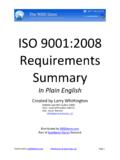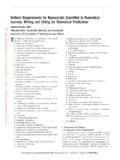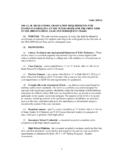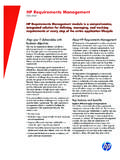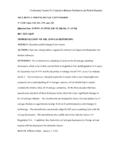Transcription of NFPA 30-2008: Basic Requirements for Storage Tanks
1 NFPA 30- 2008 : Basic Requirements for Storage Tanks New York City Metro Chapter Society of Fire Protection Engineers New York, NY February 22, 2011 1 NFPA 30, Flammable and NFPA 30, Flammable and Combustible Liquids Code Combustible Liquids Code Storage Storage TanksTanksNew York City Metro ChapterSociety of Fire protection EngineersFebruary 22, 2011 The BasicsThe basics What is a flammable liquid? Fundamental hazardous property of flbldbtibl liidflammable and combustible liquids is.
2 Their ability to produce ignitiblevaporsPropertiesProperties vapor pressure & boiling point flash point temperature at which vapors above liquid's surface can be ignitedliquid s surface can be ignited fire point temperature at which liquid will ignite & sustain fire2 PropertiesProperties autoignition temperature vapor-air density liquid density water miscibility water miscibility water miscible liquids are afire fighting challengePropertiesPropertiesVapor Boiling Evaporation FlashPressurePoint Rate PointClassification Classification ClassFlash PointBoiling PointIA< 73 F ( C)< 100 F ( C)IB< 73 F ( C) 100 F ( C)IC 73 F 100 F ( - C)II>100 F - <140 F(>60 - < C) )III 140 F ( 60 C) IIIA 140 F - < 200 F ( 60 C - < 93 C)IIIB>200 F (> 93 C)
3 3 NFPA 30 Reorganized in 2008 NFPA 30 Reorganized in 2008 Old Chapters1 -3 Administrative4 Tank Storage5 PipingNew Chapter Groups 1 -4 Administrative5 -8 General Requirements9 -16 Container Storage6 Container Storage7 Operations8 Electrical17 -20 Operations21 -26 Tank Storage27 -29 Piping, Bulk TransferBulk Storage TanksBulk Storage Tanks1 -4 Administrative5 -8 General Requirements21 Requirements for All Tanks22 Aboveground TanksRequirements9 -16 Container Storage17 -20 Operations21 -26 Tank Storage27 -29 Piping.
4 Bulk Transfer22 Aboveground Tanks23 Underground Tanks24 Storage Tank Storage Tank Vaults26 Reserved Types of Storage TanksTypes of Storage Tankssingle wall double wall closed-top dike fire resistant orprotected4 Chapter 21 Chapter 21 GeneralGeneral applies to Storage of flammable and combustible liquids in fixed Tanks exceeding 60 gal. (230L) portable Tanks and IBC S > 793 gal. (3,000 L) portable Tanks connected to fixed piping not used for processingChapter 21 Chapter 21 GeneralGeneral Basic design Requirements tank can be of any shape.
5 Size or type must be constructed per recognized engineering standardsengineering standards aboveground Tanks cannot be used as underground Tanks nor vice versaChapter 21 Chapter 21 GeneralGeneral materials of construction recognized engineering standards for the material of construction being used steel or other approved noncombustible steel or other approved noncombustible material must be compatible with liquid stored can be lined, if necessary special engineering required ifspecific gravity of liquid > 21 Chapter 21 GeneralGeneral combustible materials of construction permitted: underground where required by liquid properties where required by liquid properties Class IIIB liquids: outside abovegroundwhere not exposed to a spill/leak of Class I or Class II liquid.
6 Inside a building protected by an automatic fire-extinguishing 21 Chapter 21 GeneralGeneral common design standards API Standard 650, Welded Steel Tanks UL 58, Underground Tanks UL 80,Steel Tanks for Oil Burner Fuel UL 80, Steel Tanks for Oil Burner Fuel UL 142, Steel Aboveground Tanks UL 1316, FGRP Underground Storage Tanks UL 1746, External Corrosion Protection Systems for Steel Underground Tanks UL 2080, Fire Resistant Tanks UL 2085, Protected Aboveground 21 Chapter 21 GeneralGeneral maximum operating pressures for ambient pressure Tanks psi gauge for vertical cone roof Tanks psi gauge, if designed to Appendix F of API Standard 650 psi gauge for horizontal cylindrical or rectangular tanks6 Chapter 21 Chapter 21 GeneralGeneral maximum operating pressures for low pressure Tanks .
7 To 15 psi API 620, Large, Welded, Low-Pressure , Storage Tanks ASME Code for Unfired Pressure Vessels, Section VIII, Division 1 Chapter 21 Chapter 21 GeneralGeneral maximum operating pressures forpressure vessels: > 15 psi ASME Code for Unfired Pressure Vessels, Section VIII, Division 1 or 2 Chapter 21 Chapter 21 GeneralGeneral vent must prevent vacuum or pressure that: can distort the roof of a cone roof tank can exceed the design pressure of the tank maximumrate of flow in or out maximum rate of flow, in or out atmospheric or temperature changes size vent per API 2000 or approved standard min 1 in.
8 (32 mm) or largest 21 Chapter 21 GeneralGeneral vent termination devices for Class IA liquids: normally closed venting devices pressure-vacuum (conservation vent)typical pressure-vacuum ventChapter 21 Chapter 21 GeneralGeneral vent termination devices forClass IB and Class IC liquids normally-closed venting devices listed flame arresters listed flame arresters no vent termination devicesrequired for Class II orClass III liquids8 Chapter 21 Chapter 21 GeneralGeneral protection from internal corrosion additional metal thickness approved protective coatings or tank failed at the weld between the shell and the tank bottom due to 21 Chapter 21
9 GeneralGeneral testing Requirements Shop-built and site-built Tanks must be tested before being placed in service. use tank construction standard use tank construction standard listed Tanks exempt Tightness Test ( ) for site-built Tanks , test above is sufficient use water or air 3 to 5 psigChapter 21 Chapter 21 GeneralGeneral fire hazard analysis required fire & explosion hazards on the site local conditions threat from adjacent properties threat from adjacent properties environmental conditions fire protection systems where indicated emergency action plan training and drills inspection and maintenance9 Chapter 21 Chapter 21 GeneralGeneral overfill prevention procedures / systems required for Tanks > 1,320 gal.
10 (5,000 L) storing Class I or Class II liquids aboveground Tanks receiving / aboveground Tanks receiving / transferring Class I liquids from pipelines or marine vessels must have written proceduresChapter 21 Chapter 21 GeneralGeneral identification and security NFPA 704 placard unsupervised, isolated aboveground Tanks must be secured from tampering ortanks must be secured from tampering or trespassingChapter 21 Chapter 21 GeneralGeneral Tanks in areas subject to floods must have means to secure tank from displacementTanks after Hurricane Katrina10Ch.

